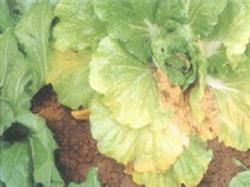Control measures of yellow leaf disease (shedding disease) of Chinese cabbage

Chinese cabbage yellow leaf disease is a general term for fungal yellow leaf disease of Chinese cabbage. Chinese cabbage, yellow bud white and other Chinese cabbage, pakchoi and yellow leaf disease occur from north to south. The disease occurred in the seedling stage. The harmful fungus mustard is Fusarium oxysporum, which belongs to the subphylum of semisciferous bacteria. The disease can be controlled by chemical spraying or field management. First, disease symptoms of heading Chinese cabbage, yellow bud white and other Chinese cabbage, Chinese cabbage, yellow leaf disease occurred from north to south. The disease occurred in the seedling stage. After setting or planting, the growth is slow, half of the leaves fade green, half or the whole leaves wilt, seem lack of water, pull up the diseased plants, few whisker roots, cut open the main root, vascular bundles turn brown. After rosette to the early stage of the core, the leaves begin to yellowing, enter the middle stage of the core, the veins of the old leaves fade and turn yellow, the veins remain dark green around the veins, and the rear margin is dehydrated, wrinkled and curled inward, causing the plant to atrophy or die. Second, the pathogen characteristic mustard belongs to Fusarium oxysporum, which belongs to the subphylum of semiknowns. The conidia and hyphae are initially white and then gradually turn brown to pink; there are large and small conidia: few large conidia, cylindrical to sickle-shaped, both ends pointed, with small protuberances at the base, more than 2 to 3 membranes, size 25 ~ 33 × 3.5 ~ 5.5 microns; small conidia many, ovate to elliptic, unicellular, size 6 ~ 15 × 2.5 ~ 4 microns. Chlamydospores are terminal or mesophytic and do not produce conidia, mucinous conidia and sclerotia. Third, the way of transmission of the bacteria survives in the soil. In dry years, the soil temperature is too high or lasts too long, which causes burns to the roots distributed in the tillage layer, and the secondary roots extend slowly, which not only affects the water absorption of seedlings, but also causes the roots to become cork gradually and cause disease. According to the investigation, the disease is serious in some years or out-of-season cultivation in Shaanxi, Hubei, Yunnan, Sichuan and other places, and it has become an important disease in cabbage production. Fifth, control methods (1) select disease-resistant varieties. (2) sowing at the right time, generally not too early, try to avoid the high temperature and dry season. (3) strengthen field management. Moderate squatting seedlings, change the habit of squatting "full moon" to prevent soil drought at seedling stage, if the soil temperature is too high in seedling drought years, we should frequently water and cool down to ensure the normal development of roots. Medicament method (1) it is not suitable to flood irrigation at seedling stage, and spray it with "Egenol + Capuke" in time after seedling. (2) when setting the market, 50% carbendazim 1000g 30% carbendazim 100ml + Japanese granular magnesium 3000g was used to irrigate the root once, and the amount of water used per plant was about 200ml. (3) during the vertical tube period, 50% carbendazim 1000 g chlorothalonil 75% chlorothalonil 1000 g + potassium dihydrogen phosphate 2kg was irrigated once per mu, and the amount of water used per plant was about 150ml. (4) less nitrogen fertilizer, more phosphorus, potassium and magnesium fertilizer (5) combined with pest control and disease prevention, 30% chlorpromazine water agent (10ml per bucket of water) (6) when ploughing and soil preparation, humic acid can be added in real time to apply 80kg-100kg per mu.
- Prev

Cultivation techniques of Chinese Cabbage in Spring
Spring Chinese cabbage, summer Chinese cabbage and early spring Chinese cabbage have no strict harvest time, and can be harvested after heading. The harvest time of autumn and winter Chinese cabbage is strict and must be harvested before the low temperature of-2 degrees Celsius appears. After the storage of Chinese cabbage is harvested, the leaf ball is facing north and the root facing south for 2-3 days. Then pile the plants in two rows.
- Next

Technical measures for Disease Control of Chinese Cabbage
Downy mildew, virus disease, soft rot and dry burning heart disease are the main diseases of Chinese cabbage. The main results are as follows: 1. Downy mildew can occur from seedling stage to pericardial stage, mainly harming Chinese cabbage leaves. At first, the disease begins from the lower leaves, producing water-immersed, yellowish polyhedral spots on the leaves, and gradually enlarged and turned into yellowish brown.
Related
- Where is it suitable to grow horseradish in China? it is expected to see the middle altitude horseradish in Alishan.
- How to prevent tomato virus disease reasonably? (Control methods included)
- Many people like to plant towel gourd on the balcony. What are the main points of this method and management?
- What crops can chili peppers be mixed with?
- Fertilization techniques and matters needing attention in Tomato
- What are the grafting techniques for peach seedlings in spring?
- Harm and control methods of root swelling disease of Chinese cabbage
- What are the pests of sweet potatoes? How to prevent and cure it?
- Symptoms, causes and Control methods of navel Rot in Tomato
- The cause of "Cucumber rotten bibcock" in Farmers' planting Cucumber and its Control Plan

